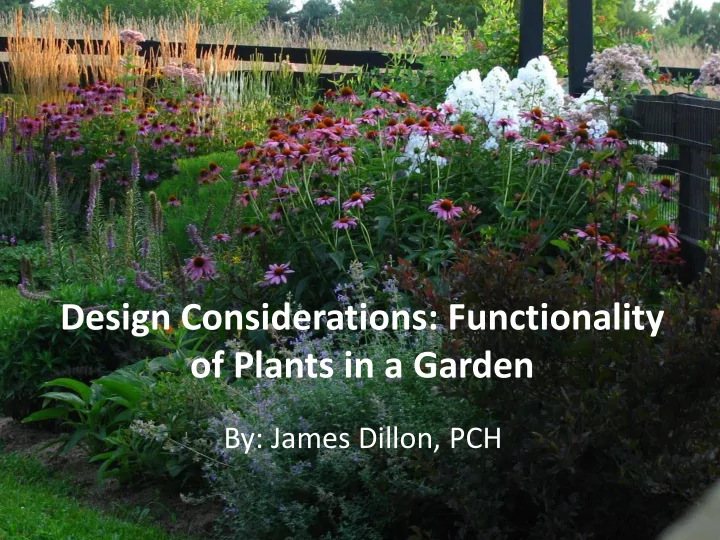

Design Considerations: Functionality of Plants in a Garden By: James Dillon, PCH
Todays challenges: Invasive Plants Knotweed Stiltgrass Kudzu Garlic Mustard
Johnson Grass Japanese Honeysuckle Burning Bush Invasion Norway Maple in Fall
Deer Herbivory
Pressures on plant communities and wildlife • Habitat loss • Habitat fragmentation • Climate change • Deer herbivory • Pollution • Pesticides • Invasive plants and animals • Drought/flooding
What does this mean? • Decline of pollinators due to lack of food, diminishing habitat and pesticides • Decline of insects in general • Leads to decline of birds (most birds need insects feed to young and plants for seeds/cover) • Leads to drop in diversity of species • Leads to lack of balance in environment which favors invasive species and further degradation Rusty Patched Bumble Bee By USGS Bee Inventory and Monitoring Lab from Beltsville, Maryland, USA
“All hands on deck” approach • Conservation of habitat • Invasive plant management • Habitat restoration • Agriculture practices (e.g. pollinator strips) • Roadside planting/management • Public land management • Private land management • Reduced/responsible pesticide use • Residential gardens • Rain gardens
Inspiration and How-to Courtesy of Timber Press
Novel Plant Communities Design by: James Hitchmough Olympic Gardens Stratford, England
Novel Plant Community at my house Design by: James Dillon, PCH
Getting the most “bang for the buck” Limited space in our yards means we have to make every inch count - Specific plants are required by certain caterpillars (e.g. Butterflies and Moths) - Super Genera are plants that feed many insects and host MORE butterflies/moths - Planting for continuous bloom from spring through fall - Limit/eliminate insecticide use - Control invasive plants so native plant communities thrive
Another useful list from Dr. Tallamy
Canada Goldenrod at The Center for Environmental Stewardship 9/24/16
Design with the end in mind • First, Identify Goals of the Planting Examples: – Home foundation planting designed with high aesthetics, to work with architecture/infrastructure, while lowering maintenance, and being productive ecologically – Pollinator garden or Monarch waystation – Soil stabilization – Lawn reduction – Lower maintenance – Green mulch/less mulching – Permaculture/food – Aesthetic goals – Screening/frame views – Garden rooms – Ecological purposes (e.g. meadow) – Stormwater mitigation (e.g. rain garden)
All plantings require maintenance Decide what level of maintenance from the start! • Decide how your planting will be managed right from the design phase – Vigorous spreading plants can cut back on maintenance but limits species diversity (i.e. “thug” taking over) - Vigorous plants can get out of hand so it’s necessary to learn how it spreads and its active growth period - Not productive for many species! – Diverse/layered plantings can be low maintenance too! - Maintenance becomes knowledge-based instead of labor-based - Supports diversity of species of insects and birds promoting balanced systems - Can evoke natural ecosystems and be beautiful
Plant Profile: Short-toothed Mountain Mint Pycnanthemum muticum
Lowering Garden Maintenance Requires Looking at Plants as Functional Entities and Changing Old Patterns • Less mulching = Plants as Green Mulch • Less weeding = Layered planting with no bare ground – Layered Planting = Plants that occupy various niches in the garden: • Ground Cover Plants (50%) • Seasonal Theme Plants (25-40%) • Structural Plants (10-15%) • Filler Plants (5-10%) • Less Pruning = Instead Monitoring/managing perennial planting replace traditional need to sheer and thin shrubs
Monoculture vs. Diverse Planting A singe species leaves a lot of ground that requires mulch to stabilize: A diversity chosen carefully can occupy separate niches above and below ground: Plants with complimentary shapes above and below ground fit more tightly together and tolerate being side by side.
Plants Organized According to Function in the Garden or Plant Community
Groundcovers with Semi-Evergreen to Evergreen Basal Foliage (50% of planting) ‘Eastern Star’ White Wood Aster Carex eburnea (Ivory Sedge) Chrysogonum virginianum (Gold Star)
Groundcovers in Action February, 2016
Seasonal Theme Plants (25-40% of planting) Black Eyed Susan Butterfly Weed Aster ‘October Skies’
Structural Plants (10-15% of planting) ‘Jacob Cline’ Bee Balm Little Bluestem ‘Gateway’ Joe Pye Weed
Plant Profile- ‘Winterthur Viburnum’ • Tolerates wet conditions as well as drought • Multiple seasons of interest • Ecologically valuable (host plant, nectar/pollen, friut)
Filler Plants (5-10% of planting) Wild Geranium Cardinal Flower Wild Columbine
Limiting factors -Learn to work with the conditions on a site rather than attempting to alter. Attempts to alter the site can result in more issues dealing with weeds. • Reflected heat • Existing vegetation • Aspect (e.g. direction • Sun/Shade slope facing) • Wet/Dry Soil • Rich soil • Drainage/Hydrology • Impoverished soil • Acid pH • Engineered soil • Alkaline pH • Salt exposure • Exposed/Windy site • Deer herbivory • High pollution
Aesthetics • In order for my plantings to be successful, they need to be aesthetically pleasing Piet Oudolf
…even during winter! But how? Piet Oudolf
Foliage/Flower Textures and Forms Piet Oudolf, NY High Line Park
Piet Oudolf
Physical Traits of Plants Kiwanis Park, Hagerstown MD Design by: James Dillon, PCH
Physical Traits: Form and Flower Shape Iris ‘Carsar’s Brother’ ‘ Jelena ’ Phlox Switchgrass ‘ Karmina ’ Geranium ‘Little Joe’ Joe Pye Weed ‘Blue Fortune’ Agastache Purple Coneflower Swamp Milkweed
An amplified or enhanced depiction of nature Design by: James Dillon, PCH
Form and Winter Interest Piet Oudolf
Embracing Diversity Kiwanis Park Monarch Waystation Design by James Dillon, PCH
Who will care for these diverse, new landscapes? …not these guys
More required reading: Thank you!
References and Websites • Rainer, Thomas, and Claudia West. Planting in a post-wild world: designing plant communities for resilient landscapes, OR: Timber Press, 2015. Print • http://www.fairfaxcounty.gov/parks/greenspring/infosheets/butterfliesandm oths.pdf • http://www.wildtypeplants.com/butterfly.pdf • http://www.northcreeknurseries.com/ • https://www.nps.gov/plants/alien/pubs/midatlantic/midatlantic.pdf • http://www.newmoonnursery.com/ • New York Invasive Species Information • http://www.loudounwildlife.org/PDF • http://www.gloucesterva.info/Portals/0/mg/documents/HelpDesk/LocalGard ening/ButterfliesBees/NativePlantsButterflyHost.pdf • http://www.bringingnaturehome.net/what-to-plant.html • http://gardeningwithconfidence.com/blog/wp- content/uploads/2015/11/Doug-Tallamys-List.pdf • http://www.biologicaldiversity.org/programs/population_and_sustainability/ extinction/
Recommend
More recommend